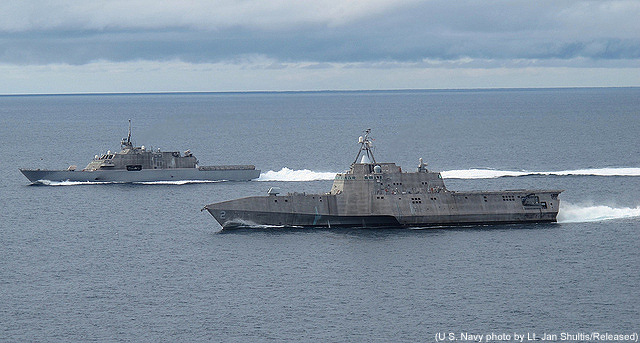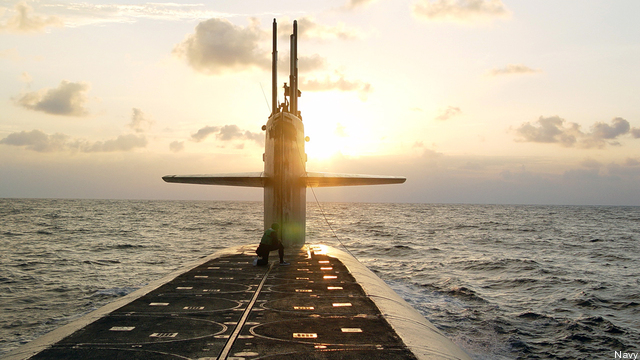What The HASC Seapower Mark Means For The Navy
Posted on
This marks the first of our monthly op-eds by Rep. J. Randy Forbes, chairman of the House Armed Services seapower and projection forces subcommittee. We will send a Tweet before posting each one so you’ve got some notice. Read on! The Editor
At the start of my first column, I would like to thank the editors of Breaking Defense for giving me the opportunity to directly address their readership on a periodic basis. I also want to thank the editors for granting me the flexibility to address what matters, when it matters, and to accommodate Congress’ busy schedule. Having just put the finishing touches on my (House Armed Services) Seapower and Projection Forces Subcommittee’s mark of the fiscal 2017 National Defense Authorization Act (NDAA), it seems appropriate to use this first column to address what is in the mark and what it means for the Navy.
Since 2011, when the Budget Control Act put a cap on defense spending and spawned the threat of sequestration, the military services has been under tremendous fiscal pressure. While specific threats and general instability seem to have grown in every corner of the globe, funding for the armed forces has been reduced by roughly 20%. Five years ago, our nation was spending 5% of its GDP on national defense, now we are spending 3.4%—approximately what we were spending in the relatively carefree days of the mid-1990s.
Despite renewed attention to the Asia-Pacific region and to the growing challenges and importance of projecting power in contested environments, the Air Force, Marine Corps, and Navy have not been exempt from these cuts. The Navy is now struggling meet the demands placed upon it with a fleet of only 272 ships. A few weeks ago, Members of Congress were shocked to hear from Admiral Harry Harris that the Navy has been meeting only 60% of his demand for submarines in Pacific Command. Only a few days later, however, I received a memo from the Navy stating that in Fiscal Year 2017, the service anticipates that it will meet only 42% of combatant commanders’ demands across the board. Admiral Harris’ predicament, it turns out, is unfortunately above average.
In this strategic and budgetary context, we have heard from senior defense officials that the Navy must choose between presence and posture, capability and capacity. The undeniable reality, however, is that our Navy and its sister services need more of both. Fortunately for the sea services, it is to Congress, not the White House’s Office of Management and Budget, that the Constitution grants the power “to provide and maintain a navy.” This Congress has demonstrated repeatedly that it accords more importance than the administration to the strength and health of our Navy, and I am pleased to report that this year’s National Defense Authorization Act will prove that. In its Seapower and Projection Forces mark, my subcommittee rejects false choices and further cuts, starts bending the curve lines in a positive direction, and makes a down payment on the 350-ship Navy that I sincerely believe we need for national defense.
Among other things, our subcommittee’s mark:
- Authorizes a total of $20.6 billion for shipbuilding. This funding is split between the traditional “SCN” account and the National Sea Based Deterrence Fund (), a new account that our subcommittee established to fund the $100 billion-dollar Ohio Replacement Program. This figure is $2.3 billion higher than the President’s budget request. Accounting for inflation, it is the highest level of shipbuilding funding since fiscal 1988, the year in which President Reagan and Secretary Lehman authorized two aircraft carriers in one year and came the closest they would ever come to 600 ships. As noted above, this year’s shipbuilding funding includes the first $733 million in procurement funding for the Ohio Replacement Program, which the mark transfers into the cost-saving NSBDF.
- Authorizes 10 major ships, three more than requested in the President’s budget. On top of the 2 Virginia-class submarines, two Littoral Combat Ships, two Aegis Destroyers, and one LHA requested by the administration, the mark restores funding for the third LCS cut at OSD’s direction, provides the funding needed to build a third destroyer that appropriators partially funded last year, and provides funding and authority for the Secretary of the Navy to either accelerate procurement of the next-generation LX(R) amphibious ship or procure a 13th San Antonio-class LPD. At the same time, the mark directs the Navy to assess the capacity of submarine industrial base and present Congress with options for increasing SSN procurement, and expresses the sense of Congress that aircraft carriers should be built with “centers” spaced 4, not 5, years apart. This 20% acceleration would increase carrier force structure and prevent a return to a 10-carrier fleet in the 2040s.
- Prohibits budget-driven cuts to Navy force structure. Over the past few years, we have seen budget pressures drive the Navy to propose one ill-advised force structure cut after another, and this year was no different. Our mark forces the administration to adhere to the “2-4-6” compromise that Congress and the Navy reached on cruiser and amphibs modernization, and holds the administration accountable by holding at risk a chunk of OSD funding until the Navy enters into contracts for the modernization of those ships. It also prohibits retirement of the 11 remaining MCM ships until their replacements are ready. All told, the mark extends statuary protections over 23 ships—1/12th of the Navy fleet. It also denies the administration’s request for a waiver to deactivate one of our 10 carrier air wings and its constituent squadrons. In doing all of the above, we have worked with other subcommittees to ensure that the Navy is provided with the O&M and manpower funding it needs to keep these units operational and avoid a hollow force.
- Enhances Navy lethality. Proving that we can increase capacity and capability at the same time, our mark increases modernization and weapons procurement while also expanding force structure. It authorizes procurement of critically-needed munitions like the Long Range Anti-Ship Missile (LRASM) and SM-6, doubles procurement of the venerable Tomahawk, and funds Aegis combat system upgrades for an additional destroyer. It funds the procurement and integration of over-the-horizon missiles on both classes of LCS, an unfunded Navy requirement that will accelerate the up-gunning of these platforms and the realization of distributed lethality. It also invests in game-changing technologies, and authorizes an additional $20 million for the Navy’s new rapid prototyping and experimentation efforts in order to encourage and accelerate innovation.
- Gets more bang for our buck. While increasing the Navy’s top line, the mark also reduces costs for the Navy and the taxpayer by authorizing bulk purchases, maintaining steady production rates, and achieving economies of scale. It adds a new authority to the NSBDF for “continuous production” that will enable the Navy to procure ORP components like missile tubes in one larger production runs at substantially lower prices. It also accelerates advance procurement of CVN-81 components and authorizes the Navy to buy parts for CVN-80 and 81 at the same time, another buy-in-bulk provision that should substantially reduce the costs of these important platforms. And by increasing purchase quantities, the mark achieves economies of scale on things like MQ-8C Fire Scout drones. While the administration planned to procure 1 MQ-8C for $72 million, the mark authorizes four more aircraft for only $48 million more, reducing the per-unit cost by two thirds.
All in all, I believe that the House Armed Services seapower and projection forces subcommittee mark sends a strong signal of congressional support for strengthening our Navy. I am grateful for the bipartisan support of our subcommittee, and for the opportunity to discuss our mark on Breaking Defense. Readers of this site will likely know that I often talk about national defense, the threats we face, and the capability and capacity of our armed forces in terms of trend lines. For many years, we have seen those lines trending in the wrong direction. With this mark, however, I believe we are bending those curve lines in the right direction and taking some early, important steps toward the 350-ship Navy we so clearly need.
Subscribe to our newsletter
Promotions, new products and sales. Directly to your inbox.



